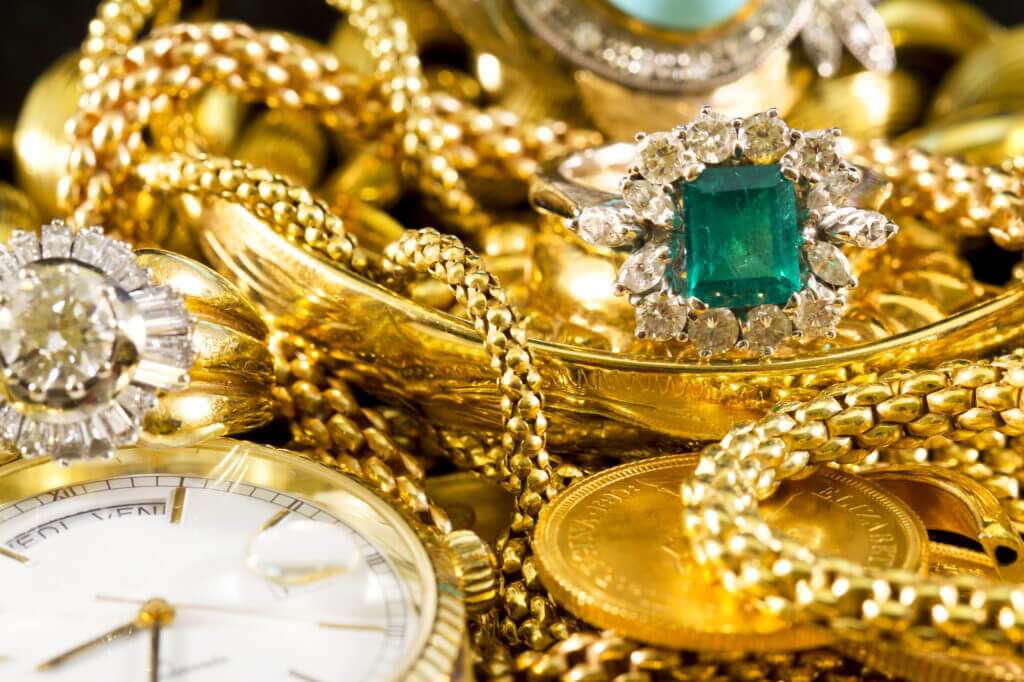A Quick Guide to Gold Marks on Gold Jewelry and Watches From An Orlando Antique Jewelry Buyer
Getting information from an experienced Orlando antique jewelry buyer is the best way to learn the actual value of your gold jewelry and watches.
As professional Orlando antique jewelry buyers and estate buyers, we’ve seen all sorts of gold marks on vintage and antique gold jewelry and pocket watches. It’s not a simple matter of looking for a “14k” or “18k” hallmark; there are a lot of nuances that go into identifying gold marks.
Identifying Marks on Antique Jewelry
In this document we’ve condensed much of our experience from the last 34 years into a quick guide format, so you can get an overview that will cover about 95% of the marks you may run into when evaluating your family’s jewelry. Keep in mind this is a very basic overview, designed to help family members who are going through the estate’s jewelry to help them determine which pieces are fine jewelry versus costume jewelry.
One quick disclaimer: There are MANY pieces of unmarked gold jewelry. It may be custom-made with no maker’s marks or purity marks. It could be a very old ring that originally had marks, but they have worn off over the years. It may be a chain that was repaired with an unmarked clasp. It may be from the 19th or 18th century, where unmarked custom jewelry was much more common.
In nearly every large collection of costume jewelry we evaluate, we find unmarked gold jewelry. While this guide is very useful in identifying marked gold (and gold plated or gold filled jewelry) we strongly recommend you have an expert evaluate your entire collection to ensure all of your hidden treasures have been uncovered.
What do the Gold Marks on my Jewelry Mean?
Gold marks are typically in fractional Karat format or decimal format. To determine the purity of fractional or Karat gold marks, simply divide the Karat by 24.
- 10k, or 10/24ths purity. Often noted as “.417” on European jewelry.
- 14k, or 14/24ths purity, or .585
- 18k, or 18/24ths purity, or .750
- 9k or c9 or 9c, or 9/24ths purity, or .375. This is not typically found on US jewelry but is common on gold jewelry from the UK, South Africa and Australia.
21k/22k High Karat Gold Marks
As an Orlando antique jewelry buyer, we typically see high Karat gold from the Middle East and Asia. We see a fair amount of older French and Portuguese gold is not marked with either a Karat or a fraction mark; these countries (and many other European countries) would use a hallmarking system similar to the ones seen on sterling silver. Typical marks may be a small animal’s head, sometimes with a nearly microscopic number. These marks may be on the OUTSIDE of the ring as well, which is an unusual place for the markings and is sometimes overlooked.
Below is a picture of Chinese chop marks from a 22k bangle bracelet. China and Hong Kong have produced a lot of high Karat gold over the years, so if your family hails from or traveled to these regions you may see some of these items in your collection.

Pure 24 Karat Gold Jewelry
This is super rare. Gold is very soft and malleable and is too prone to bending and denting to be used as jewelry in its purest form. This is why the gold used in jewelry is typically 14 or 18 karat; other hard metals such as silver, copper, zinc and platinum are melted with the gold to create a stronger alloy that endows the gold with the strength to be made into necklaces, prongs to mount gemstones, and bangle bracelets that don’t lose their form too easily.
In my many years of purchasing and assaying estate jewelry as Orlando antique jewelry buyers, the only 2 forms we’ve come across that are nearly pure are 1) Asian wedding bands (I think Korean if memory serves) and Indian (Asian, not American) bangle bracelets. These bangle bracelets are worn misshapen and out of round, showing off the fact that they are pure or near-pure gold and don’t keep their form well.
Gold Filled Fraction Marks
1/10 12k, 1/20 GF, etc: Any variation of this type of 1/xx mark denotes gold-filled jewelry, which is a higher quality form of gold plating. Unlike its modern cousin electroplating, which adheres tiny amounts of gold to jewelry that cannot be reclaimed, gold-filled jewelry has a fairly thick layer of gold over the base metal underneath.
Think of it kind of like a gold sandwich; two thin layers of gold with some type of base metal underneath. There are lots of pieces of Victorian-era gold-filled jewelry that have significant collectible value, but even modern gold-filled has enough gold that it could be melted down and re-purposed into modern jewelry or pure gold bullion. As a rule of thumb, we pay about the same price for gold-filled jewelry as we do for sterling silver.
14k GE or 18k GE: This mark almost always denotes gold electroplated jewelry. It is most common on rings. This is typically low-value costume jewelry, but there are always exceptions…
This blog post is merely scratching the surface of an extensive field of study, but again, it should cover about 95% of the MARKED pieces you will find. To find all of your unmarked gold, you will need years of experience, a testing kit, and a keen eye. Fortunately, you have an expert Orlando antique jewelry buyer with all of these tools at your disposal. Call Chad Busby with Busby Estate Liquidations today!







